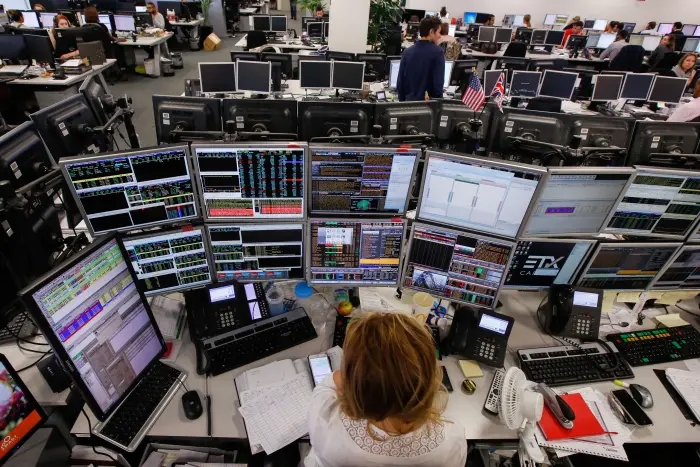
Equity markets remain on the backfoot, with the S&P500 on track to post a sixth consecutive daily fall. US Treasuries are in a consolidation mode tracking sideways, while currencies have shown only small movements, the NZD tracking not far off yesterday’s high ahead of the RBNZ MPS this afternoon.
US equities opened on a very weak note and with some evident rotation out of some high-growth favourites such as Tesla and “stay-at-home” stocks, driving the Nasdaq index down as much as 3.9% before buyers returned. The S&P500 is currently down 1%, while the Nasdaq index is down 2½%. “Boring” sectors like utilities, real estate, consumer staples and financials are all up, while the IT and consumer discretionary sectors show falls of more than 2%. In a sign of the anti-momentum trade, Bitcoin continues to head lower after Elon Mush tweeted over the weekend that the price “seemed high”, trading as low as $45,000 after stretching above $58,000 at its recent high.
Some of the recovery from the intraday low has been attributed to Fed Chair Powell remaining overtly dovish as he gave his semi-annual testimony to lawmakers. He repeated the now-familiar message that the economy is a long way from the Bank’s employment and inflation goals and it will likely take “some time” for substantial further progress to be achieved, the condition for reducing the current level of stimulus. He added that “the economic recovery remains uneven and far from complete, and the path ahead is highly uncertain”.
In the Q&A we didn’t notice any fresh insights. When asked about the recent rise in Treasury yields, Powell noted that rates are moving up due to higher growth expectations, with more confidence in the economy. We’d note that this is a correct assessment for February, with higher real rates driving the most recent move higher, but prior to February much of the move reflected higher inflation expectations. Overnight, the US 10-year rate has been a bit jumpy, oscillating between 1.34-1.39%.
In economic data, US consumer confidence nudged up by slightly more than expected. UK employment fell by more than expected, lifting the unemployment rate to 5.1%, the highest in nearly five years, which heavily understates the true picture as almost 4 million jobs are associated with wage subsidies.
Overnight currency movements have been small, with all the majors we closely follow within 0.2% of the NZ close. The NZD has consolidated above 0.73, revisiting the 0.7340 mark within the last couple of hours, just short of the near three-year high of 0.7343 reached just after we went to press yesterday morning. The AUD has settled down around 0.7900. NZD/AUD hit a fresh low of 0.9235 yesterday, before trending higher to 0.9280.
In the domestic rates market, global forces saw rates push up to fresh highs in the morning, before a decent reversal ensued. By the close of play, rates were lower across most of the NZGB and swaps curve, in the order of 1-3bps. In overnight trading, Australian 10-year bond futures have remained choppy, with the implied yield up 7bps from the NZ close (apologies for getting the sign wrong in yesterday’s daily). This will set the tone in early trading today for the NZ market, as it did yesterday. The RBA didn’t do any “yield curve control” yesterday to lower the 3-year bond to its 0.1% target. The market awaits the RBA’s next move on that front to see how committed the Bank is to defend that target.
Focus turns to the RBNZ’S Monetary Policy Statement this afternoon. A lot has changed since the Bank’s last forecast update in early November, including the rolling out of vaccines, a much better global outlook, clear evidence of stronger domestic inflationary pressure and a much better than expected labour market. Much less monetary stimulus will be required to achieve the Bank’s inflation and employment objectives. The key question is how the RBNZ will frame the policy outlook. We suspect the tone will be along the lines of “We've made good progress towards reaching our objectives but let us not forget we are still living in a pandemic. Monetary policy needs to remain stimulatory to ensure we make further progress".
We think it’s likely the Bank reaffirms, at this stage, that it will buy bonds under its QE programme until June 2022, and there is a chance the MPC guides the market towards expecting some further gradual tapering in the pace of purchases this year. The Bank will want to avoid a post-MPS surge in the NZD, but as we have seen post the RBA’s overtly dovish early-February Statement, the Bank’s ability to hold back the NZD is limited, if not non-existent, against the backdrop of the global reflation trade.
Daily exchange rates
Select chart tabs
3 Comments
Imagine if someone sat passively on a fence and remained there, and watching commentators tried to describe their (in)activity in dynamic language such as ‘hawkish’ or ‘dovish’
“It’s not what he says, it’s what he doesn’t say, watch for a telling raise of his eyebrows”.
In the words of Shakespeare nothing but ‘inexplicable dumbshows and noise’.
NZD rises super strong with a better credit rating, and rising agricultural commodity prices, and buying from returning Kiwis. I guess NZD is heading toward 80c against USD and 70c against Euro.
After the pandemic, NZD showed over a 10% increase in most currencies.
Unstoppable.




We welcome your comments below. If you are not already registered, please register to comment.
Remember we welcome robust, respectful and insightful debate. We don't welcome abusive or defamatory comments and will de-register those repeatedly making such comments. Our current comment policy is here.